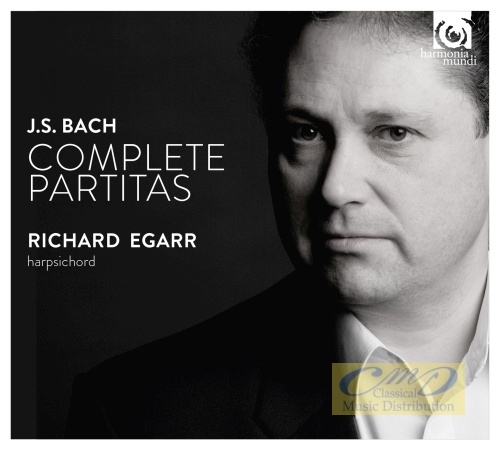
classical music distribution


(Produkt nie został jeszcze oceniony)
kompozytor
Bach, Johann Sebastian
tytuł
Bach: Complete Partitas BWV 825-30
wykonawcy
Egarr, Richard
nr katalogowy
HMM 907593.94
opis
Any composer s Op.1 is a big deal. Bach modelled his own after Kuhnau s 'Neue Clavier Übung', books 1 and 2 of which were published in 1689 and 1692. Bach s ability to see and create a long-term project has its spooky beginnings here. Although the music that inhabits the six Partitas was ready and waiting, rather than publish them together, Bach staggered their delivery. Partita 1 came in 1726, with the other five appearing gradually over the next four years, until finally in 1731 the entire six Partitas were presented as his Clavir [sic] Ubung . . . Opus 1 . . . 1731 . Bach infuses this seemingly effortless music with godly patterns and personal algorithms of stunning brilliance. Many pages have been spent in the pursuit of secret codes in Bach s music: for many, a contentious subject. Bach began by publishing Partita 1 in 1726 when he was 41 years old. Needless to say the final movement of the set (the 41st movement), has as its theme a subject containing 14 notes. The family name not only gave rise to a direct musical melody [BACH = B flat/A/C/B natural], but for Johann Sebastian a pair of deliciously mirrored numbers with which he was wont to sign his name at beginnings and endings in particular. If A=1, B=2 etc. (I and J are counted as the same letter), then: BACH = [2+1+3+8] 14 JSBACH = [9+18+14] 41 The above is wilfully paraphrased from Richard Egarr's own superb notes from this new recording of the Partitas; crowning his already extensive series of Bach's harpsichord works, and illuminating every one of their multiple facets.
• Bach, J S: Partita No. 2 in C minor, BWV826
• Bach, J S: Partita No. 3 in A minor, BWV827
• Bach, J S: Partita No. 4 in D major, BWV828
• Bach, J S: Partita No. 5 in G major, BWV829
• Bach, J S: Partita No. 6 in E minor, BWV830
• Bach, J S: Partitas Nos. 1-6, BWV825-830
Works:
• Bach, J S: Partita No. 1 in B flat major, BWV825
• Bach, J S: Partita No. 2 in C minor, BWV826
• Bach, J S: Partita No. 3 in A minor, BWV827
• Bach, J S: Partita No. 4 in D major, BWV828
• Bach, J S: Partita No. 5 in G major, BWV829
• Bach, J S: Partita No. 6 in E minor, BWV830
• Bach, J S: Partitas Nos. 1-6, BWV825-830
nośnik
CD
x 2
gatunek
Muzyka klasyczna
producent
Harmonia Mundi
data wydania
02-02-2017
EAN / kod kreskowy
3149020759325

(Produkt nie został jeszcze oceniony)
cena 129,00 zł
lubProdukt dostępny.
Wysyłka w ciągu 3 dni roboczych
Darmowa wysyłka dla zamówień powyżej 300 zł!
Darmowy kurier dla zamówień powyżej 500 zł!
sprawdź koszty wysyłkiProduktu jeszcze nie zrecenzowano, chcesz być pierwszy?
Klienci, którzy kupili ten produkt, kupili również
Pozostałe płyty tego kompozytora
różni kompozytorzy
100 Meisterwerke geistlicher Chormusik - Bach; Händel; Mendelssohn; di Lasso; Haydn; Praetorius; Schubert; Schütz; Brahms; Beethoven; Mozart; …
PH 14013
Bach, Johann Sebastian, Telemann, Georg Philipp
Bach & G.P. Telemann: Concertos for Viola and Bassoon
PSC 1326
różni kompozytorzy
Lost in Venice with Prometheus - Bach, Beethoven, Wagner, Liszt, Nono, Holliger
FUG 716
Bach, Johann Sebastian
WYCOFANY Bach: L'orgue concertant - sinfonias, sonates & concertos
LDV 118.0
Bach, Johann Sebastian
Bach: Cantatas vol. 28 (Ascension Day) - BWV 43, 37, 128, 11
SDG 185
Pozostałe płyty tego wykonawcy
różni kompozytorzy
WYCOFANY Generation Harmonia Mundi - The Family Spirit, 1988 / 2018
HMX 2908920.37
Napisz recenzję dla: Bach: Complete Partitas BWV 825-30
Zapytaj o dostępność produktu
Twoje zapytanie:
Odpowiemy na adres:
Produkt został dodany do koszyka

Bach, Johann Sebastian
Bach: Complete Partitas BWV 825-30
1 szt












































